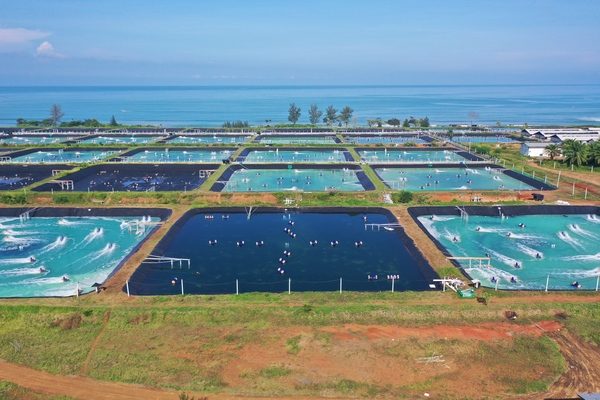This is the Ideal Vannamei Shrimp Pond Design and Construction
It is important to have the ideal vannamei shrimp pond design and construction before starting cultivation. This is because ponds are an environment where shrimp grow and develop.
Strong vannamei shrimp pond construction is needed to run the cultivation process well. The construction of these ponds directly affects the management of water, waste, cultivation activities, and harvest.
So, what is the ideal shrimp pond design and construction? Read more in this article.
Also Read: This Is the Best Water Color for Vannamei Shrimp Pond
Ideal Vannamei Shrimp Pond Design
Before carrying out vannamei shrimp farming, farmers must carefully consider the design of their vannamei shrimp ponds. This is because the pond design will affect the cultivation carried out.
In general, things that need to be considered in the design of vannamei shrimp ponds include the length and width of the plot, depth, berm size, bund size, perimeter canal size, and location of the floodgates.
1. Pond Map Design
The shape and area of the pond plots depend on the level of technology used. The shape of the pond that has been chosen is rectangular or square. However, apart from that, there are also circular ponds.
For rectangular pond plots, the longest side should be less than 150 m. This is so that the water flow from one side to the other can cause a fairly strong current.
In addition, the longest side of the pond should be perpendicular to the direction of the wind so that the wind does not cause strong waves of water. Conversely, if the longest side of the pond is parallel to the wind direction, the water waves in the plot will be strong and can damage the bunds.
2. Bund Design
Vannamei shrimp pond bunds must be designed to accommodate the maximum possible water level. The height of the bund must be based on the highest tide ever.
In addition, several things that are no less important to note are that the bunds must be able to protect the delimited area from water pressure. Therefore, it must be ensured that the bunds must be strong enough, not easily broken by water pressure, and not easily eroded.
Generally, shrimp pond bunds are divided into main, secondary, and tertiary bunds. Each of these bunds has a different design and size and has been adapted to its function.
The main bund is a bund that is made around the entire pond area and functions to protect the area from flooding. The main bund design must be given a certain distance from the water source as a buffer area.
Secondary bunds are designed similarly to primary bunds to maintain water levels and are strong enough to withstand water pressure. The recommended width for this secondary bund is 1.5 meters.
3. Channel Design
Shrimp pond channels have two types. The first type is the open type, with the best trapezoidal cross-section, where the water flows following the direction of the earth’s gravity. The second type is the closed type, usually used for intensive ponds and distributes water pumped from the sea.
Shrimp pond channel design is done by determining the slope of the channel, the width of the channel bottom, the capacity of the channel, and the slope of the channel walls
Also Read: Get to Know the Vannamei Shrimp as a Farmers’ Favorite
Construction of Vannamei Shrimp Ponds
In constructing vannamei shrimp ponds, various technical aspects must always be considered so that the cultivation is carried out sustainably. From the stages of work to be carried out, labour requirements, processing time, work arrangements, and the amount of equipment needed.
Construction of shrimp ponds must be carried out following the design and layout of the ponds that have been determined previously. In contrast, the work starts with making bunds and laying ponds, canals, and sluice gates.
Based on the Ministry of Maritime Affairs and Fisheries Regulation No. 75 of 2016 concerning General Guidelines for Enlargement of Tiger Shrimp (Penaeus monodon) and Vannamei Shrimp (Litopenaeus vannamei), good shrimp pond construction has criteria including:
- Have sufficient water availability during low tide, at least seawater.
- Has no dead point.
- The bund as an access road in the pond must be passable by vehicles and workers.
- Land use and equipment for shrimp ponds must be effective and efficient.
- Guaranteed maximum safety and security at work.
In addition, the construction of shrimp ponds must be made in such a way as to ensure the smooth operation of the pond during cultivation. From pond preparation, stocking of shrimp fry, and shrimp enlargement process, to harvest.
Additionally, vannamei shrimp ponds must have an effective and efficient design and construction by adjusting costs incurred without reducing technical functions and maintaining environmental sustainability.
Also Read: 4 Elements of Vannamei Shrimp Farm Management That Must Be Considered
Manage Your Vannamei Shrimp Farm With DELOS!
The design and construction of vannamei shrimp ponds are important factors in the cultivation’s success. This is because this directly affects the management of water, waste, cultivation activities, and harvests.
Indeed, determining the design and construction of ponds must be done promptly. Everything must be carefully planned for extensive, semi-intensive, intensive, or super-intensive cultivation.
You can manage your vannamei shrimp pond with DELOS for the best cultivation results.
DELOS is the best science, technology, and operational management-based aqua-tech company that can help you explore new opportunities in aquaculture.
DELOS pond management is also integrated with AquaHero, which makes it easy for farm owners and farm personnel to monitor shrimp pond conditions in real time through gadgets at any time.
To join DELOS, contact us via contact@delosaqua.com or submit your questions in the contact column on our website, www.delosaqua.com. Manage your vannamei shrimp pond with DELOS!



